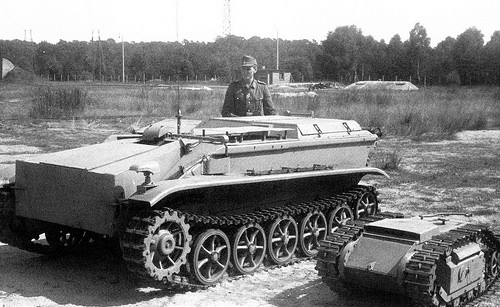Goliath Mine Description
The Goliath Mine is a German self-propelled ground tracked mine vehicle (abbreviated Sd.Kfz. 302/303a/303b/3036) used during WWII. The structure carried 75-100 kg of explosives and was intended to destroy tanks, dense infantry formations and the destruction of buildings. “Goliath” was disposable, as it was intended for self-destruction. At first the Goliaths used an electric motor, but since they were expensive (3000 Reichsmarks) and difficult to repair, later models (known as SdKfz. 303) used a simpler and more reliable 12 hp gasoline engine . Although the total Goliath Mines produced was 7564, this weapon was not considered successful due to its high cost, low speed (9.5 km/h), low cross-country ability, wire vulnerability and thin armor (10 mm), which was unable to protect the self-propelled mine from any form of anti-tank weapons. Late model Goliaths cost approximately 1,000 Reichsmarks, in comparison, a 75mm Pak 40 anti-tank gun cost 12,000 Reichsmarks.

Goliath Mine at Vadim Zhodorojni Museum
Application
“Goliath” was used by the German army during the Second World War (in particular, to destroy the barricades during the Warsaw Uprising ).
Against the Red Army “Goliaths” were first used in the summer of 1943 during the Battle of the Kursk Bulge. Later, one of the captured “Goliaths” was transferred to the permanent exhibition of captured weapons organized in 1943 in Moscow (exhibited under the name ” German tankette-bomb for fighting tanks”). Since the beginning of 1945, the intensity of their use increased.
Assessment and testing of Goliath Sd.Kfz. 302 in the USSR
In 1943, a self-propelled mine “Goliath” Sd.Kfz entered the NIBT test site for study and testing. 302 (where it was simply called “German torpedo tankette”). Moreover, experts believed that it was a means specially designed specifically to combat Soviet tanks.
According to the results of the survey, the following characteristics were indicated: the mass of the explosive was estimated at 70 kg, and the total weight of the tankette with a charge was about 200 kg. The length of the supporting part of the caterpillar is 800 mm (specific ground pressure – 0.1 kg / cm²), and the possible speed of movement is up to 20 km / h. The body of the wedge is made mainly of 1 – 2 mm steel sheets. Each track consists of 48 tracks, stamped from 2 mm steel sheet – a later version of the Goliath had stamped tracks. Early vehicles had cast aluminum track links.
A Goliath Mine without a remote control came at the disposal of Soviet specialists and they had to make its own replacement. In addition to studying the German electrical circuit of the torpedo (experts considered that the vehicle lacks some of its parts), the NIBT proving grounds also proposed their own simplified electrical circuit for controlling the tankette.”The wedge-torpedo is controlled from a remote control connected to the wedge by a three-core wire, 250m long. The wire is wound on a coil located in the aft part of the wedge. part of it. ”
In the journal “Bulletin of Tank Industry”, NIBT specialists give the following final characteristics (it should be borne in mind that the tests were carried out by a captured, partially incomplete vehicle and some judgments may be erroneous, since the disposable suicide vehicle had a very limited resource):
“Moving Mines can be used to ambush tanks, most often on roads. However, the effectiveness of such mines turned out to be low. With a ground clearance of only 160 mm , it encounters insurmountable obstacles everywhere (stones, logs of firewood, etc.). It has enough power supply for only 5-8 minutes of movement. It is difficult to get such a torpedo under a moving tank even from a distance of 100 – 150 m. ”

Goliath Mine WWII Footage

Goliath Mine Cutaway/ Diagram

Reflection in culture and art
Shots with his participation are shown in the episode of the 1957 film “Channel”.
Shots with his participation are shown in the episode ” Soldiers of Freedom ” by Yu. Ozerov in the second film, dedicated to the Warsaw Uprising.
Shots with his participation are shown in the film “City 44”
In the Company of Heroes series of games, “Goliaths” are used as a combat unit of the Wehrmacht.
You can also find “Goliath” in the real-time strategy Behind Enemy Lines: Assault 2
In the tactical shooter Sniper Elite 4 during a joint mission on the Depot map, “Goliath” appears as a secret development that must be destroyed.
In the War Selection strategy, Goliath is available for production in the transition to the second industrial revolution behind Germany.












